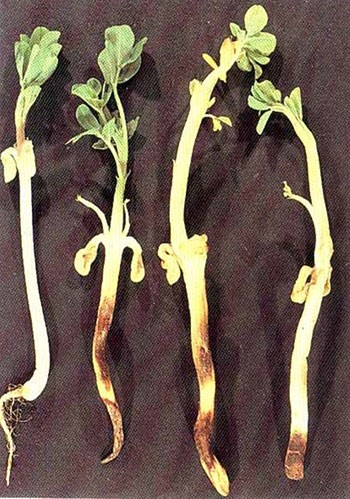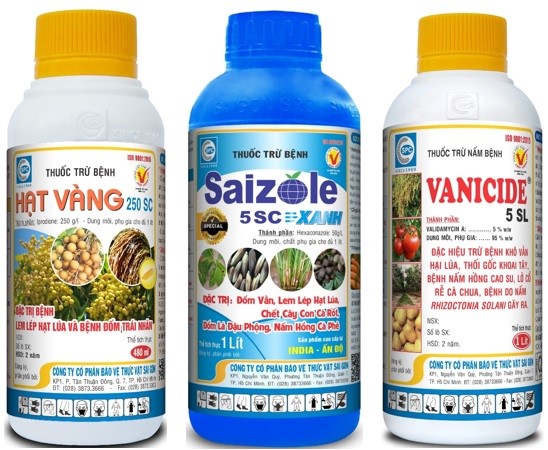|
DEATH DISEASE OF PEANUT SEEDLINGS
21/06/2023
DEATH DISEASE OF PEANUT SEEDLINGS Seedling death (root rot) is a common disease for a number of crops such as peanuts , tomatoes, carrots, melons, peppers... Seedling death is especially common in specialized growing areas, or areas where secondary crops are grown for many years. In low-humidity areas, areas with hot and humid weather, the disease is often severe. At present, seedling death on several secondary crops is still a problem for many farmers.
Disease symptoms and harms: The disease usually arises in the small stage of the plant, However, it is most commonly encountered when the plants are just growing or newly planted. The plant is green but suddenly withers during the day, especially in the late afternoon. At night and early in the morning, the plant may turn green again if the disease is mild. If you look at the part of the plant close to the ground, you can see that the stem is shrinking and discolored, or sometimes the roots are rotten. If we do not have the right and timely prevention measures, the disease can cause death of each cluster or whole, and loss of garden density. Pathogens and conditions of development: Seedling is usually caused by The Rhizoctoniasolani fungus is the main cause. The disease usually develops in the areas where peanuts and secondary crops are grown. Seeds and seedlings carry pathogens and have not been treated before sowing. Soils with a lot of remnants of previous crops, low-humus and low-lying, moist soil, and with many soil-dwelling pests such as Striped flea beetle, the disease is also easy to develop and thrive. Effective management measures: The principle is to apply a combination of many measures: -Clean the remnants of the crop first. If the garden is often damaged, it is necessary to treat the soil before planting, for example, applying lime powder. Plow the soil to dry if possible before planting. - Raise a high bed so that the soil and garden are well ventilated. Do not make the soil too small, do not compact the soil when planting, because the soil is easily blocked and anoxic after planting. - Fertilize barn manure that has been incubated with Trichoderma-resistant fungi so that the soil is porous and drained. Or use probiotics containing resistant fungi. - Use disease-resistant varieties, varieties that have been treated before sowing. Use healthy seeds in a trusted establishment to limit the source of disease. -When caring, avoid injuring and cutting the roots. -Watering really well, should be watered in furrows, not on the surface of the beds, limiting the garden to too wet. Do not let the water regime change suddenly to easily break the roots. Do not water from other gardens overflow into the garden. -When the tree has just grown, if the garden has ever had a seedling death disease, it should be sprayed and watered for prevention with one of the products such as SAIZOLE 5SC, HAT VANG 250SC, VANICIDE 5SL. |
To prevent, in addition to plowing and burying weed seeds, collecting weed stalks and stumps left after tilling the land to burn, not letting weeds produce seeds in production fields, etc., the use of chemical products is still a measure. optimal because of its ability to thoroughly kill weeds, reduce labor and take advantage of more time than manual weeding.
Miner has the scientific name Phyllocnistis citrella Staint., family Phyllocnistidae, order Lepidoptera. The miner occurs in many countries in the tropics and subtropics. The main host of the miner is the citrus family - Rutaceae. In addition, the miner also attacks mangosteen and some other plants.
Adult is a small planthopper, with a body 2-3 mm long, the whole body is ash gray, slightly greenish, the wings are opaque with many small brown spots.Eggs are oval, 0.3 mm long, have a pointed end and are attached directly to the leaf surface, leaf axils.
Green bugs specialize in the fruit of citrus groups (oranges, tangerines, lemons, grapefruits, kumquats...), some people call them orange bugs, or orange suckers. Their scientific name is Rhynchocoris poseidon or Rhynchocoris humeralis.
In Vietnam, yellow leaf curl disease is very common on papaya trees, especially the disease is often severe in areas of high and continuous planting, areas with hot and arid climates. The disease has significantly reduced the yield and quality of papaya. Gardens that are infected early when the plants are young may not yield. However, up to now, many gardeners still do not know the cause and how to fix it.
Spider mites are common pests on citrus trees, especially in hot and dry climates that are suitable for spiders to grow and cause severe damage.The group of harmful spiders is usually very small in size, unlike the natural enemy spiders.
This group includes species that are generally very small in size, causing damage by sucking plant sap (on leaves, fruits, branches, stems).
There are many species of mealybugs present on the group of Oranges,Tangerines,Grapefruits and Lemons (Citrus), which can be divided into 2 groups:
+ Group of sticky mealybugs with common varieties such as Lepidosaphes, Aonidiella, Coccus and Saissetia.
+ Group of flower mealybugs with common genera and species such as Pseudococcus, Planococcus and Icerya purchasi.
Dry branches and berries disease often appear to be common damage on coffee gardens during the rainy season. The disease causes death of branchs, dry fruit, severely affects the canopy structure and coffee yield if not paid attention to prevention.
Pink disease commonly causes diseases on rubber plantations in the rainy season, especially on garden from 4-8 years old. This year, rubber has to go through a period of severe drought, weakening the tree, so now in tnshe rainy season it is easy to get infected. Therefore, it is necessary to pay attention to good management to avoid affecting the garden.
In recent years, the area of citrus has been expanded because it is a fruit tree with high economic efficiency. However, in order to sell at a high price, not only in quality but consumers also require the external beauty of the fruit, so pest management on citrus is a matter of great concern to farmers. The hot season is a favorable condition for thrips to develop and cause damage, affecting the commercial value of fruit.
- Headquarters
- SAIGON PLANT PROTECTION JOINT STOCK COMPANY
- RQ 1, Nguyen Van Quy St., Tan Thuan Ward, HCM City
- Tax code: 0300632232
- Tel: (028) 38 733 295 - 38 732 077
- Fax: (028) 38 733 003 - 38 733 391
- Website: www.spchcmc.vn - Email: info@spchcmc.vn
- SAIGON PLANT PROTECTION COMPANY
- SAIGON PLANT PROTECTION JOINT STOCK ENTERPRISE
- Lot C1-C3 Hiep Phuoc Industrial Park, Hiep Phuoc Commune, HCM City
- Tel: (028) 3873 4089 - Fax: (028) 3873 4086
- Affiliated Unit
-
- Quick Links
- Home
- About us
- Career Opportunities













